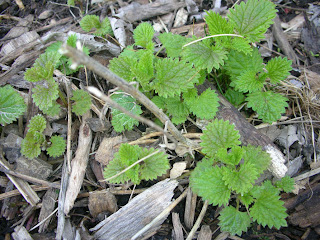Spring is here! Now is the time to get outside as much as possible and exploring your herbal ally is the perfect excuse to be outside.
For the next two weeks, we will be visiting our herbal ally daily if possible, sitting and meditating for 5-10 minutes.
In Susun Weed’s article You Can Have a Green Ally (http://www.susunweed.com/herbal_ezine/December04/healingwise.htm) her first exercise is:
Sit and breathe with your green ally for 3-10 minutes a day. You breathe out and the plant breathes in; the plant breathes out and you breathe in.
We are going to progress our daily meditation with our ally over the course of two weeks.
Further Reading:
The Lost Language of Plants by Stephen Harrod Buhner (online article: http://www.gaianstudies.org/articles2.htm)
The Lost Language of Plants by Stephen Harrod Buhner (you can see excerpts of the book here: http://www.susunweed.com/Excerpt_Language_of_plants.htm) or see on google reader: Lost Language of Plants
Assignment 1:
Sit with your herbal ally for 5-10 minutes each day. Expect nothing, offer nothing but your gratitude for this ally. Close your eyes, clear your mind and picture your ally. Breathe in, picturing your ally breathing out. Breathe out, picturing your ally breathing in. As you breathe out carbon dioxide, your ally breathes in carbon dioxide. As you breathe in oxygen, you ally breathes out oxygen. Realize that you and your ally have a dependency on each other for life. You share each others resources so that you both may live. Feel this in your heart as you focus on your ally you are sitting next to.
Sit with your herbal ally for 5-10 minutes each day. Expect nothing, offer nothing but your gratitude for this ally. Close your eyes, clear your mind and picture your ally. Breathe in, picturing your ally breathing out. Breathe out, picturing your ally breathing in. As you breathe out carbon dioxide, your ally breathes in carbon dioxide. As you breathe in oxygen, you ally breathes out oxygen. Realize that you and your ally have a dependency on each other for life. You share each others resources so that you both may live. Feel this in your heart as you focus on your ally you are sitting next to.
Assignment 2:
Each day after your 5-10 minute meditation, journal any experiences you had during this exercise. It’s best to take your journal with you so you can sit and write before getting up and being distracted by other thoughts. This can be just a few words, a drawing or a story, anything that comes to your mind after exchanging oxygen and carbon dioxide with your ally. How do you feel? What did you see in your visualization with your ally?
Each day after your 5-10 minute meditation, journal any experiences you had during this exercise. It’s best to take your journal with you so you can sit and write before getting up and being distracted by other thoughts. This can be just a few words, a drawing or a story, anything that comes to your mind after exchanging oxygen and carbon dioxide with your ally. How do you feel? What did you see in your visualization with your ally?
Continue Assignments 1 and 2 for 7 days. After 7 days, continue on to the next assignments:
Assignment 3:
Sit with your ally as before. Greet your ally and thank him for his herbal wisdom he is offering to you. Start your meditation with the first exercise, breathing in and out while visualizing your ally doing the same and sharing resources with you. After becoming focused, ask your ally why he chose you or why you were drawn to him. Stay aware of your breath and try to keep your mind clear. Your ally may or may not choose to share wisdom. Don’t be discouraged if you don’t get any answers at first. Your answer may come in the form of a thought, an emotion or an impression. After a few minutes, whether or not you have any communication with your ally, thank your ally for his wisdom and offer gratitude for him.
Sit with your ally as before. Greet your ally and thank him for his herbal wisdom he is offering to you. Start your meditation with the first exercise, breathing in and out while visualizing your ally doing the same and sharing resources with you. After becoming focused, ask your ally why he chose you or why you were drawn to him. Stay aware of your breath and try to keep your mind clear. Your ally may or may not choose to share wisdom. Don’t be discouraged if you don’t get any answers at first. Your answer may come in the form of a thought, an emotion or an impression. After a few minutes, whether or not you have any communication with your ally, thank your ally for his wisdom and offer gratitude for him.
Assignment 4:
Again, journal any thoughts you have from your daily meditation.
Again, journal any thoughts you have from your daily meditation.
Continue Assignments 3 and 4 for the next 7 days.
After two weeks of daily meditation, compare your journal entries and see if you notice any changes with your thoughts, feelings and impressions you’ve kept track of.
Assignment 5:
Continue with your infusions, using your oils and vinegars and journaling about your experiences.






































